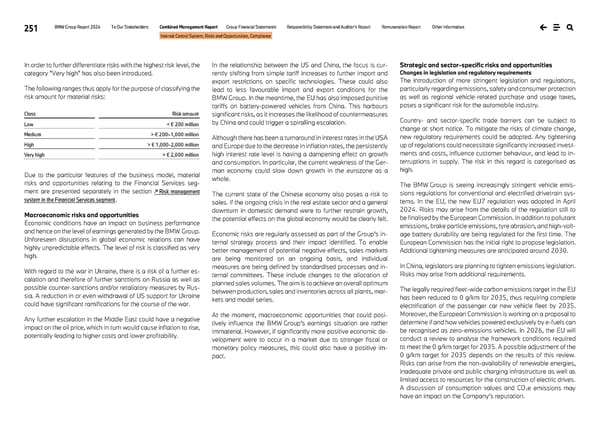251 BMW Group Report 2024 To Our Stakeholders Combined Management Report Group Financial Statements Responsibility Statement and Auditor’s Report Remuneration Report Other Information Internal Control System, Risks and Opportunities, Compliance In order to further differentiate risks with the highest risk level, the category "Very high" has also been introduced. The following ranges thus apply for the purpose of classifying the risk amount for material risks: Class Risk amount Low < € 200 million Medium > € 200–1,000 million High > € 1,000-2,000 million Very high > € 2,000 million Due to the particular features of the business model, material risks and opportunities relating to the Financial Services seg- ment are presented separately in the section ↗ Risk management system in the Financial Services segment. Macroeconomic risks and opportunities Economic conditions have an impact on business performance and hence on the level of earnings generated by the BMW Group. Unforeseen disruptions in global economic relations can have highly unpredictable effects. The level of risk is classified as very high. With regard to the war in Ukraine, there is a risk of a further es- calation and therefore of further sanctions on Russia as well as possible counter-sanctions and/or retaliatory measures by Rus- sia. A reduction in or even withdrawal of US support for Ukraine could have significant ramifications for the course of the war. Any further escalation in the Middle East could have a negative impact on the oil price, which in turn would cause inflation to rise, potentially leading to higher costs and lower profitability. In the relationship between the US and China, the focus is cur- rently shifting from simple tariff increases to further import and export restrictions on specific technologies. These could also lead to less favourable import and export conditions for the BMW Group. In the meantime, the EU has also imposed punitive tariffs on battery-powered vehicles from China. This harbours significant risks, as it increases the likelihood of countermeasures by China and could trigger a spiralling escalation. Although there has been a turnaround in interest rates in the USA and Europe due to the decrease in inflation rates, the persistently high interest rate level is having a dampening effect on growth and consumption. In particular, the current weakness of the Ger- man economy could slow down growth in the eurozone as a whole. The current state of the Chinese economy also poses a risk to sales. If the ongoing crisis in the real estate sector and a general downturn in domestic demand were to further restrain growth, the potential effects on the global economy would be clearly felt. Economic risks are regularly assessed as part of the Group's in- ternal strategy process and their impact identified. To enable better management of potential negative effects, sales markets are being monitored on an ongoing basis, and individual measures are being defined by standardised processes and in- ternal committees. These include changes to the allocation of planned sales volumes. The aim is to achieve an overall optimum between production, sales and inventories across all plants, mar- kets and model series. At the moment, macroeconomic opportunities that could posi- tively influence the BMW Group's earnings situation are rather immaterial. However, if significantly more positive economic de- velopment were to occur in a market due to stronger fiscal or monetary policy measures, this could also have a positive im- pact. Strategic and sector-specific risks and opportunities Changes in legislation and regulatory requirements The introduction of more stringent legislation and regulations, particularly regarding emissions, safety and consumer protection as well as regional vehicle-related purchase and usage taxes, poses a significant risk for the automobile industry. Country- and sector-specific trade barriers can be subject to change at short notice. To mitigate the risks of climate change, new regulatory requirements could be adopted. Any tightening up of regulations could necessitate significantly increased invest- ments and costs, influence customer behaviour, and lead to in- terruptions in supply. The risk in this regard is categorised as high. The BMW Group is seeing increasingly stringent vehicle emis- sions regulations for conventional and electrified drivetrain sys- tems. In the EU, the new EU7 regulation was adopted in April 2024. Risks may arise from the details of the regulation still to be finalised by the European Commission. In addition to pollutant emissions, brake particle emissions, tyre abrasion, and high-volt- age battery durability are being regulated for the first time. The European Commission has the initial right to propose legislation. Additional tightening measures are anticipated around 2030. In China, legislators are planning to tighten emissions legislation. Risks may arise from additional requirements. The legally required fleet-wide carbon emissions target in the EU has been reduced to 0 g/km for 2035, thus requiring complete electrification of the passenger car new vehicle fleet by 2035. Moreover, the European Commission is working on a proposal to determine if and how vehicles powered exclusively by e-fuels can be recognised as zero-emissions vehicles. In 2026, the EU will conduct a review to analyse the framework conditions required to meet the 0 g/km target for 2035. A possible adjustment of the 0 g/km target for 2035 depends on the results of this review. Risks can arise from the non-availability of renewable energies, inadequate private and public charging infrastructure as well as limited access to resources for the construction of electric drives. A discussion of consumption values and CO2e emissions may have an impact on the Company’s reputation.
 BMW Group Report 2024 Page 250 Page 252
BMW Group Report 2024 Page 250 Page 252